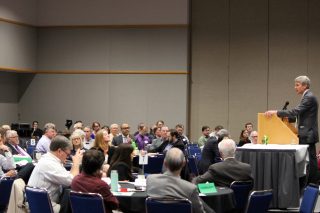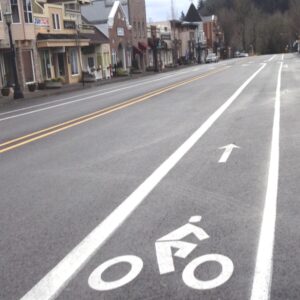
(Photo: Metro)
This article was originally submitted by Metro as a subscriber post.
Former Minneapolis Mayor R.T. Rybak praised and provoked Portland-area leaders at a forum last Friday, challenging them to work together to address growing transportation dilemmas facing Portland and metropolitan regions around the country.
Rybak, a three-term mayor from 2002 to 2014, spoke with humor, humility and bluntness at a regional leadership forum at the Oregon Convention Center, kicking off Metro’s 2018 update of its regional transportation plan.
Attendees included state legislators, local elected officials who sit on the Metro Policy Advisory Committee and Joint Policy Advisory Commmittee on Transportation, public agency staff, transportation advocates, community members and business leaders from throughout the Portland region.
Rybak’s tenure in Minneapolis was a time of great change in the city, which has 400,000 residents and co-anchors the Twin Cities metropolitan region, with a population of around 3 million.
Advertisement
His administration launched a comprehensive 10-year transportation plan called Access Minneapolis, identifying and completing new investments in transit, sidewalks, bikeways and updating transportation design guidelines. Rybak also played a key role in advancing several major bus and light rail projects in Minneapolis and its region. And, he slyly noted, Minneapolis briefly overtook Portland as the best bicycling city in the country according to Bicycling magazine.
But Rybak is intimately familiar with a hard truth about the country’s transportation system: It’s falling apart, and the consequences are real. His mayoral tenure included one of the country’s most terrible transportation tragedies. The collapse of the Interstate 35W Mississippi River bridge during an evening rush hour in 2007 killed 13 people and injured 145.
Reflecting on the lessons he’d learned, Rybak had a clear warning for local leaders: Despite the Portland region’s celebrated accomplishments, emerging trends and festering challenges both require rethinking how we approach transportation planning.
“All of us in the country and literally in the world count on Portland to lead,” Rybak said. “And it is time, I think, for you to challenge some basic assumptions.”
See highlights and watch a video of Rybak’s address at OregonMetro.gov.
[Note from Publisher: I know it might seem odd to some readers that we’ve published a post written by a government agency. Metro is a paid subscriber ($30 per month, just like 32 other businesses and organizations) and one of the perks in our subscription program is the opportunity to publish “Subscriber Posts.” When these posts come in I reserve the right to publish them here on the Front Page when and if appropriate. Just like all the other people, organizations, and businesses that support us financially, Metro’s BikePortland subscription will have no negative impact on our editorial coverage. If you have questions, please email me at jonathan@bikeportland.org.]






Thanks for reading.
BikePortland has served this community with independent community journalism since 2005. We rely on subscriptions from readers like you to survive. Your financial support is vital in keeping this valuable resource alive and well.
Please subscribe today to strengthen and expand our work.
As great as Minneapolis has gotten in the transportation front, its not all roses and sunshine. Minneapolis is having to spend $800 million in street and park maintenance.
This at a time when they (Minneapolis under Rybak) where passing out the Benjies to fund playgrounds for billionaires.
http://www.citypages.com/news/payments-on-minneapolis-spending-bender-are-coming-due-and-its-not-pretty-8235547
It certainly is not all roses and sunshine, but neither is the Rose City. The $800 million figure is spread over 20 years. I don’t see most other public spending exploded out across 20 years in the media. Still a lot, but IIRC Portland’s street maintenance backlog is in the same backlog, and that doesn’t count parks. Minneapolis’ parks backlog is pretty big, but it had far more parks infrastructure to begin with.
Why is he so unclear? Sounds like he wants to spend more money on freeways, and he wants Portland to lead the way. No thanks, we tried that for 7 decades and it didn’t work.
Take a look at a map of the Twin Cities and count all the highways. It’s as if Robert Moses had a field day.
Centerline Miles by Year – Protected Bikeways
2010 62
2014 89
2015 Minneapolis Bicycle Master Plan: 144
Are the figures cumulative, or year-by-year?
Yeah, the highways are pretty crazy. But once you get off said highways, it’s pretty bikeable. Minneapolis more so that St. Paul. The wacky thing is that no one ever counts the Grand Rounds, which is 51 miles of separated paved trails. I suppose because that is considered “recreational” riding. Still, it makes a great backbone loop to the system. See: http://wwwdocs.minneapolismn.gov/bike/index.html
And you can actually travel 20 miles in less than an hour.
Adam, you are right: Robert Moses did have a field day. As he did pretty much everywhere but Portland and Manhattan. Sadly, it’s Portland that is the outlier.
But that damage (freeway construction that cost the city of Minneapolis nearly 10% of its housing, and obliterated St. Paul’s most vibrant African-American neighborhood) was done long before Rybak came along. And despite the damage in the two core cities, most of what you see on that map is in the suburbs (which FWIW are still more bike-friendly than Portland’s suburbs). Rybak was mayor of Minneapolis, not of the Metro Council.
He did a lot. After living in Minneapolis for 16 months I can confidently say that it’s at least as bike-friendly as Portland except for the downtown core (see below). There are plenty of bike lanes in the more bike-dense neighborhoods, more and better buffered bike lanes, more protected bike lanes and of course far more miles of off-street pathways. And as pointed out above, the off-street pathways really are useful: I use them all the time to get places, and not just for recreation. Although mislabeled as MUPs, most of them are have separate pavement for wheeled vs. non-wheeled users.
The off-street paths go back decades (and are wonderful), but most of the rest has been implemented since Rybak took office. In fairness, some are newer yet, which has helped his successor acquire the epithet “Bike-Lane Betsy” among her detractors.
* About downtown: unfortunately, downtown Minneapolis is still less bike-friendly than Portland. Although Minneapolis has a lot more downtown bike lanes, many of them run along the left side (bad design IMO), they’re more frequently closed by construction projects, and the 30mph speed limits make the construction closures a bigger problem than they otherwise would be. At one point last summer I found that the Portland (!) Avenue bike lane was closed in four separate places due to construction, forcing me into traffic. This on about a 1-mile stretch of street. That said, downtown has nice paths lining both sides of the river, like Portland, but also has three car-free bridges crossing the river in the downtown area. The Broadway bridge also has protected bike lanes, and I believe the Franklin bridge is getting them as part of its rebuild this year too.
Which basic assumptions?
That quote is from 5:25 in the video, but afaict he doesn
…’t list any assumptions.
6:06 “How long will it take if we keep doing things the same way, to fully build-out a transportation system?”
6:44 “We cannot possibly get out of the congestion mess we have … if we don’t disrupt the system of how we build transportation.”
But, then he seems to mostly talk about funding capital projects — “how we *build*”. He touches a bit on the idea that “transportation consumers” need to be part of the solution — that individual choices play a big part. Also a mention of how some issues span multiple government agencies.
Answering the question around 31:00 – “We need cars … but who says the street was only about cars?”
Aside from the focus on taxes and spending, he seems to have several good points. Maybe freight doesn’t need to move at rush hour. Elected officials should make bold changes, because there’s always something else to go do if you don’t get re-elected. etc.
Given the complaints about how Oregon’s constitution and transportation funding system hamstring non-car projects, I think we need to challenge the assumption that streets should allow thru motor traffic. If we brought the conversation around to “fast-moving cars are expensive to accommodate”, we would be on a good footing to discuss how or whether to spend that money and where to collect it. Why is it we didn’t jump straight to the idea of closing streets before the street fee discussion started?
Thanks Eric, I haven’t had time to look at the video.
I would be interested to know what metro took away from his talk.
YEAH!!!!! The Utopia of Minneapolis is going to SAVE US!!!
Biking in Minneapolis:
http://kstp.com/article/stories/s3864712.shtml
The article you cited stated that crashes in Minneapolis have dropped sharply. So…YEAH!!!!!
Never really thought about it before, but I wonder how much influence the bridge collapse had on Minneapolis’s relatively quick jump into bicycle infrastructure?
Probably none.
You don’t think? Seems to me that with a bridge failure that the local DOT would have a pretty easy time of getting additional funding for many projects. Nothing drives home the idea of how important infrastructure influences our lives than a catastrophic failure of the system.
Minnesota has one of the highest local tax rates in the country – basically, it has more money than most other places to build public infrastructure. Minnesotans also trust their local governments to do the right thing more than most places – it is much more transparent, or at least residents feel that way.
I would agree with what David Hampsten said. And although Minneapolis is #2 biketown after Portland, it is in many ways more car-dependent and most people aren’t going to make the connection between a DOT freeway-project failure and the absurdities of what we spend on car infrastructure.
Minnesota spends a staggering amount of money on car infrastructure, and most people don’t question it. Fortunately a lot more people use bike infrastructure (recreationally) than in Oregon, so there’s broader support for that too.
OR, bike infrastructure might be blamed for diverting funds away from more boring maintenance needs like keeping bridges from falling down.
True, bike infrastructure is blamed, but mistakenly. The reality is that Oregon had severe, and permanent, cuts in property taxes in the early 1990s, which were then used to pay for all kind of services, including street maintenance and lighting. Since then, what little is collected is used by the city to pay for police, fire, parks (roughly in that order). To add insult to injury, any property taxes used by schools and libraries, who have separate taxing authority from cities, cuts the collections for cities. There is no sales tax in Oregon – it is normally voted 80% against when it is put on the ballot every 10 years or so. So what is left is a high income tax, which Oregonians seem to prefer to spend on prisons instead of roads, though quite a lot goes towards schools, government pensions, and debt. By state law, gas taxes can only go towards new transportation infrastructure, including a certain percentage towards biking, but not any towards maintenance.
None, except perhaps that highly corrosive pigeon dropping encrustations are not as visible as they were on the failed span as far back as1980.